With the college football championship games coming up, Dmitriy T.M. thought it was a good time to highlight the NCAA’s database that provides detailed information on graduation rates of college athletes. For each school, you can select particular sports and years. I decided to look up graduation rates for 2010-2011 at the two schools I attended: University of Oklahoma (undergrad) and University of Wisconsin-Madison (grad school).
The database reports two numbers. The Federal Graduation Rate (FGR) reports numbers for individuals who were first-time college students when they enrolled at the institution (that is, no transfer students are included, and students who transfer count negatively in the rate for their initial school, the equivalent of a drop-out); the FGR indicates how many students graduated from their initial institution within 6 years. The Graduation Success Rate (GSR) takes into account transfer students; as long as they’re in good academic standing when they transfer, they aren’t counted against the initial school’s graduation rate.
So how are student athletes doing? According to the NCAA’s analysis, if we look at the more restrictive FGR for students who began college in 2004, student athletes actually have higher graduation rates in general, especially for African Americans:
If we switch to looking at the GSR (which, again, drops transfers from the data for the initial school, rather than counting them as non-graduates), for students who began college in 2003 and 2004, overall graduation was pretty high (79 and 82 percent), but we see pretty wide disparities. White student athletes were significantly more likely to graduate than African Americans, and for both races, women were more likely to graduate than men:
Graduation rates also vary by sport. Here are the averages for male athletes who enrolled between 2000 and 2003; we see basketball and football at the lower end, while lacrosse graduated 88% of its players from that period (the two football #s refer to the different divisions):
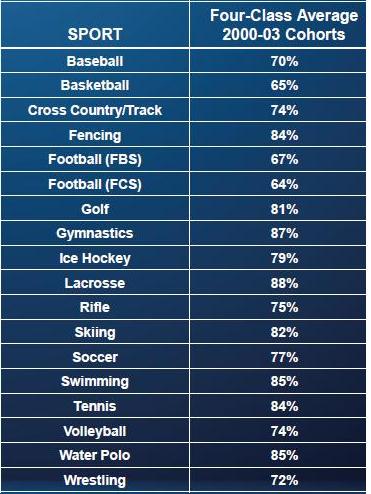
Female athletes from the same cohorts; the only sport where they didn’t have (usually significantly) higher graduation rates than men playing the same sport is rifle:
Ten-year trends for men in Division I schools in the “big three” sports:
There’s lots more detailed info available if you click the “Trends in Graduation Success Rates and Federal Graduation Rates at NCAA Division I Institutions” link at the top of the website; you can also get reports for particular schools broken down by sport, race/ethnicity, sex, etc.

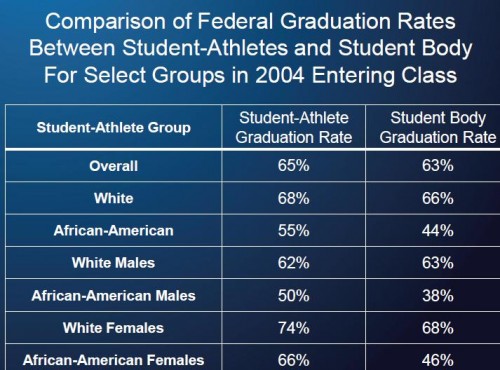
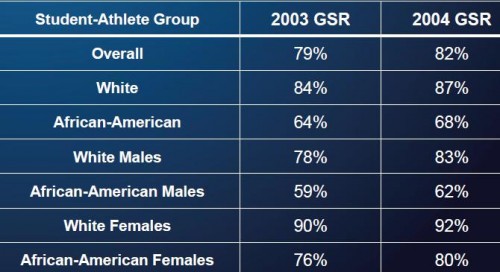
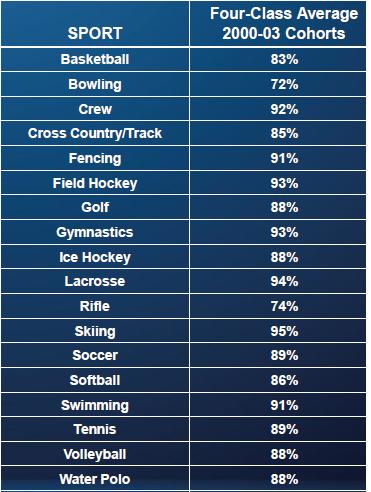
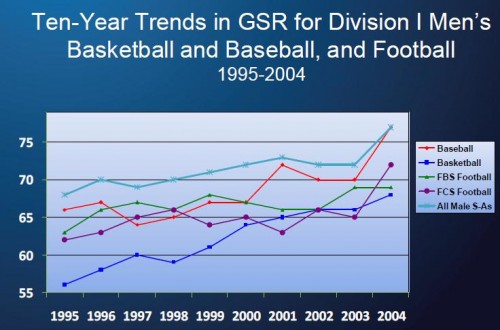
Comments 6
Anonymous — December 19, 2011
I think this is partially due to the fact that athletes are offered scholarships that would save a lot of average students from having to drop out.
I think that if you're also a great athlete the community has more of an interest in your academic success so that you can continue to be involved in sports.
Lucky — December 19, 2011
Does the study mention the trend of providing college athletes with additional academic services, like extra tutoring and academic advisement, directly through the athletic department? What about the not so subtle pressures professors often experience from these athletic advisers to ensure that their athletes maintain eligibility standards?
Anonymous — December 20, 2011
As a person who goes to school with Division 1 athletes, um....it's probably because, at least in the case of men's basketball and football, they're given free passes to do absolutely everything (no one cares about any other sports, particularly women's). They get first pick of the classes, so they snatch up all the easy ones. They get extra tutoring. The teachers feel pressured by the coaches (who have way more power and influence than tenured, experienced, well published professors) to give the athletes high enough grades for them to stay off the bench, even if they fail tests, don't show to class, and don't bother to turn in assignments. This is just academic, I could go on. Men who play sports are told, and have been told since they were children, that they are beyond the rules and regulations of the average folks. Compare the lists divided by gender; most of the female athletes have much higher graduation rates. I doubt those women have been told their whole lives "since you can play a game, your life will be set for you," so they still have to put forth enough effort to get passing grades.
There's also probably an economic aspect. The graduation rates highest on the men's chart are mostly expensive sports that have a reputation for being "high class," and may be more prominent at private schools. Someone able to afford a private school AND to be a college-level golfer, lacrosse player, or fencer probably has enough money to stay in college no matter what, save for those with scholarships, who are probably going to work hard at school regardless.